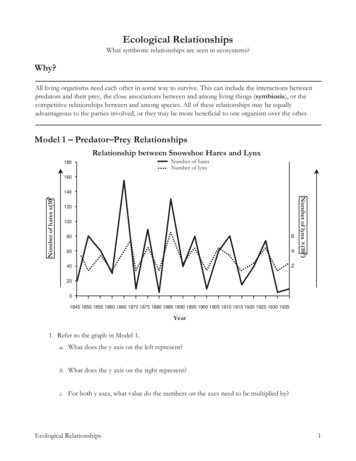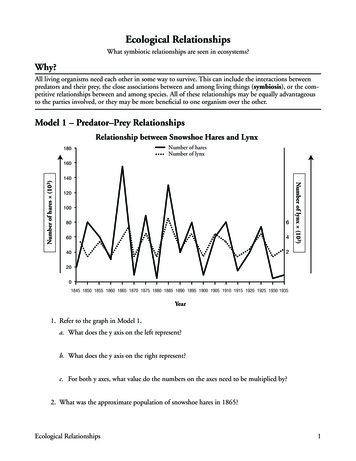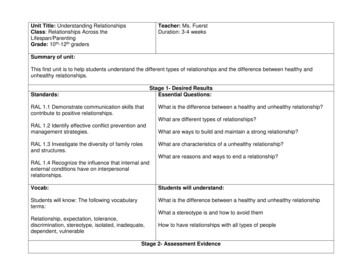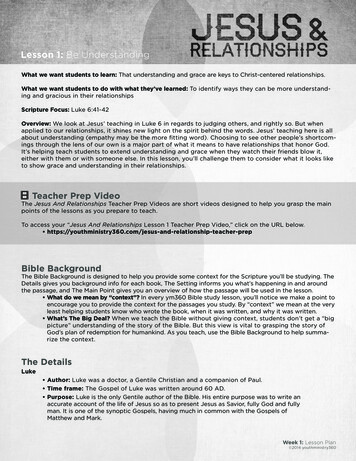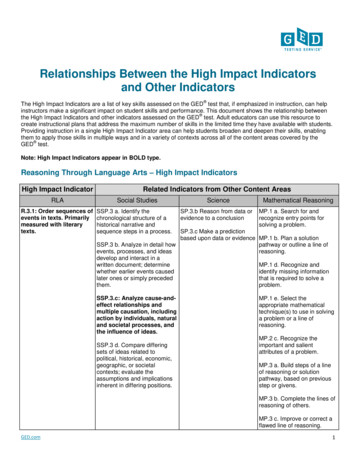
Transcription
Relationships Between the High Impact Indicatorsand Other Indicators The High Impact Indicators are a list of key skills assessed on the GED test that, if emphasized in instruction, can helpinstructors make a significant impact on student skills and performance. This document shows the relationship between the High Impact Indicators and other indicators assessed on the GED test. Adult educators can use this resource tocreate instructional plans that address the maximum number of skills in the limited time they have available with students.Providing instruction in a single High Impact Indicator area can help students broaden and deepen their skills, enablingthem to apply those skills in multiple ways and in a variety of contexts across all of the content areas covered by the GED test.Note: High Impact Indicators appear in BOLD type.Reasoning Through Language Arts – High Impact IndicatorsHigh Impact IndicatorRLAR.3.1: Order sequences ofevents in texts. Primarilymeasured with literarytexts.Related Indicators from Other Content AreasSocial StudiesSSP.3 a. Identify thechronological structure of ahistorical narrative andsequence steps in a process.ScienceSP.3.b Reason from data orevidence to a conclusionMathematical ReasoningMP.1 a. Search for andrecognize entry points forsolving a problem.SP.3.c Make a predictionbased upon data or evidence MP.1 b. Plan a solutionSSP.3 b. Analyze in detail howpathway or outline a line ofevents, processes, and ideasreasoning.develop and interact in awritten document; determineMP.1 d. Recognize andwhether earlier events causedidentify missing informationlater ones or simply precededthat is required to solve athem.problem.SSP.3.c: Analyze cause-andeffect relationships andmultiple causation, includingaction by individuals, naturaland societal processes, andthe influence of ideas.SSP.3 d. Compare differingsets of ideas related topolitical, historical, economic,geographic, or societalcontexts; evaluate theassumptions and implicationsinherent in differing positions.MP.1 e. Select theappropriate mathematicaltechnique(s) to use in solvinga problem or a line ofreasoning.MP.2 c. Recognize theimportant and salientattributes of a problem.MP.3 a. Build steps of a lineof reasoning or solutionpathway, based on previousstep or givens.MP.3 b. Complete the lines ofreasoning of others.MP.3 c. Improve or correct aflawed line of reasoning.GED.com1
High Impact IndicatorRelated Indicators from Other Content AreasRLASocial StudiesScienceR.4.1/L.4.1: Determine themeaning of words andphrases as they are usedin a text, includingdetermining connotativeand figurative meaningsfrom context. Measuredwith both informationaland literary texts.SSP.4 a. Determine themeaning of words and phrasesas they are used in context,including vocabulary thatdescribes historical, political,social, geographic, andeconomic aspects of socialstudies.SP.2.a Identify possiblesources of error and alter thedesign of an investigation toameliorate that errorMathematical ReasoningMP.1 d. Recognize andidentify missing informationthat is required to solve aproblem.MP.1 e. Select theappropriate mathematicaltechnique(s) to use in solvinga problem or a line ofreasoning.MP.5 c. Identify theinformation required toevaluate a line of reasoning.R.5.3: Analyze transitionallanguage or signal words(words that indicatestructural relationships,such as consequently,nevertheless, otherwise)and determine how theyrefine meaning,emphasize certain ideas,or reinforce an author'spurpose. Measured withboth informational andliterary texts.GED.comSSP.3 a. Identify thechronological structure of ahistorical narrative andsequence steps in a process.SP.2.b: Identify and refinehypotheses for scientificinvestigations.SP.2.e: Identify andSSP.3.c: Analyze cause-and- interpret independent andeffect relationships anddependent variables inmultiple causation, including scientific investigations.action by individuals, naturaland societal processes, andthe influence of ideas.MP.1 e. Select theappropriate mathematicaltechnique(s) to use in solvinga problem or a line ofreasoning.MP.5 c. Identify theinformation required toevaluate a line of reasoning.2
High Impact IndicatorRelated Indicators from Other Content AreasRLASocial StudiesR.8.3: Evaluate therelevance and sufficiencyof evidence offered insupport of a claim.Primarily measured withinformational texts.SSP.1 a. Determine the detailsof what is explicitly stated inprimary and secondarysources and make logicalinferences or valid claimsbased on evidence.ScienceSP.1.a Understand andexplain textual scientificpresentationsMathematical ReasoningMP.1 d. Recognize andidentify missing informationthat is required to solve aproblem.SP.2.a Identify possiblesources of error and alter the MP.1 e. Select thedesign of an investigation to appropriate mathematicalSSP.2.a: Determine theameliorate that errortechnique(s) to use in solvingcentral ideas or informationa problem or a line ofof a primary or secondarySP.2.c Identify the strengthreasoning.source, corroborating orand weaknesses of one orchallenging conclusions with more scientific investigationMP.3 a. Build steps of a lineevidence.(i.e. experimental orof reasoning or solutionobservational) designspathway, based on previousSSP.3 a. Identify thestep or givens.chronological structure of aSP.4.a Evaluate whether ahistorical narrative andconclusion or theory isMP.3 b. Complete the lines ofsequence steps in a process. supported or challenged byreasoning of others.particular data or evidenceSSP.3 b. Analyze in detail howMP.3 c. Improve or correct aevents, processes, and ideasflawed line of reasoning.develop and interact in awritten document; determineMP.5 a. Recognize flaws inwhether earlier events causedothers' reasoning.later ones or simply precededthem.MP.5 b. Recognize and usecounterexamples.SSP.3.c: Analyze cause-andeffect relationships andMP.5 c. Identify themultiple causation, includinginformation required toaction by individuals, naturalevaluate a line of reasoning.and societal processes, andthe influence of ideas.SSP.3 d. Compare differingsets of ideas related topolitical, historical, economic,geographic, or societalcontexts; evaluate theassumptions and implicationsinherent in differing positions.SSP.7 a. Distinguish amongfact, opinion, and reasonedjudgment in a primary orsecondary source document.SSP.7 b. Distinguish betweenunsupported claims andinformed hypotheses groundedin social studies evidence.GED.com3
High Impact IndicatorRLAR.8.6: Identify anunderlying premise orassumption in anargument and evaluatethe logical support andevidence provided.Primarily measured withinformational texts.Related Indicators from Other Content AreasSocial StudiesSSP.1 a. Determine the detailsof what is explicitly stated inprimary and secondarysources and make logicalinferences or valid claimsbased on evidence.ScienceSP.1.a Understand andexplain textual scientificpresentationsMathematical ReasoningMP.1 d. Recognize andidentify missing informationthat is required to solve aproblem.SP.2.a Identify possiblesources of error and alter the MP.1 e. Select thedesign of an investigation to appropriate mathematicalSSP.2.a: Determine theameliorate that errortechnique(s) to use in solvingcentral ideas or informationa problem or a line ofof a primary or secondarySP.2.c Identify the strengthreasoning.source, corroborating orand weaknesses of one orchallenging conclusions with more scientific investigationMP.3 a. Build steps of a lineevidence.(i.e. experimental orof reasoning or solutionobservational) designspathway, based on previousSSP.3 a. Identify thestep or givens.chronological structure of aSP.4.a Evaluate whether ahistorical narrative andconclusion or theory isMP.3 b. Complete the lines ofsequence steps in a process. supported or challenged byreasoning of others.particular data or evidenceSSP.3 b. Analyze in detail howMP.3 c. Improve or correct aevents, processes, and ideasflawed line of reasoning.develop and interact in awritten document; determineMP.5 a. Recognize flaws inwhether earlier events causedothers' reasoning.later ones or simply precededthem.MP.5 b. Recognize and usecounterexamples.SSP.3.c: Analyze cause-andeffect relationships andMP.5 c. Identify themultiple causation, includinginformation required toaction by individuals, naturalevaluate a line of reasoning.and societal processes, andthe influence of ideas.SSP.3 d. Compare differingsets of ideas related topolitical, historical, economic,geographic, or societalcontexts; evaluate theassumptions and implicationsinherent in differing positions.SSP.7 a. Distinguish amongfact, opinion, and reasonedjudgment in a primary orsecondary source document.SSP.7 b. Distinguish betweenunsupported claims andinformed hypotheses groundedin social studies evidence.GED.com4
Mathematical Reasoning – High Impact IndicatorsHigh Impact IndicatorRelated Indicators from Other Content AreasMathematical ReasoningSocial StudiesScienceQ.1 Apply number senseconcepts, includingordering rationalnumbers, absolute value,multiples, factors, andexponentsSSP.6 a. Integrate quantitativeor technical analysis (e.g.,charts, research data) withqualitative analysis in print ordigital text.SP.1.b Determine themeaning of symbols, termsand phrases as they are usedin scientificSSP.6 b. Analyze informationpresented in a variety of maps,graphic organizers, tables, andcharts; and in a variety ofvisual sources such asartifacts, photographs, politicalcartoons.RLASP.6.b Express scientificinformation or findingsnumerically or symbolically.SP.7.b Apply formulas fromscientific theoriesSP.8.a Describe a data setstatisticallySSP.11 a. Calculate the mean,median, mode, and range of a SP.8.b Use counting anddataset.permutations to solvescientific problemsSP.8.c Determine theprobability of eventsQ.3 Calculate and useSSP.6 a. Integrate quantitativeratios, percents and scale or technical analysis (e.g.,factorscharts, research data) withqualitative analysis in print ordigital text.SSP.6 b. Analyze informationpresented in a variety of maps,graphic organizers, tables, andcharts; and in a variety ofvisual sources such asartifacts, photographs, politicalcartoons.SP.6.b Express scientificinformation or findingsnumerically or symbolically.SP.7.b Apply formulas fromscientific theoriesSP.8.a Describe a data setstatisticallySP.8.b Use counting andpermutations to solvescientific problemsSSP.11 a. Calculate the mean, SP.8.c Determine themedian, mode, and range of a probability of eventsdataset.Q.4 Calculate dimensions,perimeter, circumference,and area of twodimensional figures andQ.5 Calculate Dimensions,surface area, and volumeof three-dimensionalfiguresSP.6.b Express scientificinformation or findingsnumerically or symbolically.A.3 Write, manipulate,solve, and graph linearinequalitiesA.7 Compare, represent,and evaluate functionsGED.com5
Science – High Impact IndicatorsHigh Impact IndicatorScienceRelated Indicators from Other Content AreasSocial StudiesSP.2.b: Identify and refine SSP.2.a: Determine thehypotheses for scientific central ideas or informationinvestigations.of a primary or secondarysource, corroborating orchallenging conclusions withevidence.Mathematical ReasoningRLAMP.1 e. Select theappropriate mathematicaltechnique(s) to use in solvinga problem or a line ofreasoning.R.2.7 Make evidence basedgeneralizations orhypotheses based on detailsin text, includingclarifications, extensions, orapplications of main ideas toMP.3 b. Complete the lines of new situations.SSP.2.b: Describe people,reasoning of others.places, environments,R.2.8 Draw conclusions orprocesses, and events, and MP.3 c. Improve or correct a make generalizations thatthe connections betweenflawed line of reasoning.require synthesis of multipleand among them.main ideas in text.MP.5 a. Recognize flaws inSSP.1 b. Cite or identifyothers' reasoning.R.5.1 Analyze how aspecific evidence to supportparticular sentence,inferences or analyses ofMP.5 b. Recognize and useparagraph, chapter, orprimary and secondarycounterexamples.section fits into the overallsources, attending to thestructure of a text andprecise details of explanations MP.5 c. Identify thecontributes to theor descriptions of a process,information required todevelopment of the ideas.event, or concept.evaluate a line of reasoning.R.5.2 Analyze the structuralSSP.7 b. Distinguish betweenrelationship betweenunsupported claims andadjacent sections of textinformed hypotheses grounded(e.g., how one paragraphin social studies evidence.develops or refines a keyconcept or how one idea isSSP.10 c. Distinguish betweendistinguished from another).correlation and causation.R.5.3: Analyze transitionallanguage or signal words(words that indicatestructural relationships,such as consequently,nevertheless, otherwise)and determine how theyrefine meaning, emphasizecertain ideas, or reinforcean author's purpose.Measured with bothinformational and literarytexts.R.5.4 Analyze how thestructure of a paragraph,section, or passage shapesmeaning, emphasizes keyideas, or supports an author'spurpose.GED.com6
High Impact IndicatorScienceSP.4.a: Evaluate whethera conclusion or theory issupported or challengedby particular data orevidence.Related Indicators from Other Content AreasSocial StudiesSSP.1 b. Cite or identifyspecific evidence to supportinferences or analyses ofprimary and secondarysources, attending to theprecise details of explanationsor descriptions of a process,event, or concept.SSP.7 a. Distinguish amongfact, opinion, and reasonedjudgment in a primary orsecondary source document.Mathematical ReasoningMP.1 d. Recognize andidentify missing informationthat is required to solve aproblem.MP.3 a. Build steps of a lineof reasoning or solutionpathway, based on previousstep or givens.RLAR.8.1 Delineate the specificsteps of an argument theauthor puts forward, includinghow the argument’s claimsbuild on one another.R.8.2 Identify specific piecesof evidence an author uses insupport of claims orconclusions.MP.3 b. Complete the lines ofR.8.3: Evaluate thereasoning of others.relevance and sufficiencyMP.3 c. Improve or correct a of evidence offered insupport of a claim.SSP.7 b. Distinguish between flawed line of reasoning.Primarily measured withunsupported claims andinformational texts.informed hypotheses grounded MP.5 a. Recognize flaws inin social studies evidence.others' reasoning.R.8.4 Distinguish claims thatSSP.10 a. Interpret, use, andMP.5 b. Recognize and useare supported by reasonscreate graphs (e.g., scatterplot, counterexamples.and evidence from claimsline, bar, circle) includingthat are not.proper labeling. PredictMP.5 c. Identify thereasonable trends based oninformation required toR.8.5 Assess whether thethe data (e.g., do not extendevaluate a line of reasoning. reasoning is valid; identifytrend beyond a reasonablefallacious reasoning in anlimit).argument and evaluate itsimpact.SSP.10 b. Represent data onR.8.6: Identify antwo variables (dependent andunderlying premise orindependent) on a graph;assumption in an argumentanalyze and communicate howand evaluate the logicalthe variables are related.support and evidenceprovided. PrimarilySSP.10 c. Distinguish betweenmeasured withcorrelation and causation.informational texts.GED.com7
High Impact IndicatorScienceRelated Indicators from Other Content AreasSocial StudiesMathematical ReasoningRLASP.6.a: Express scientific SSP.6 a. Integrate quantitativeinformation or findingsor technical analysis (e.g.,visually.charts, research data) withqualitative analysis in print ordigital text.MP.2 a. Represent real world R.9.1/R. 7.1 Draw specificproblems algebraically.comparisons between twotexts that address similarMP.2 b. Represent real world themes or topics or betweenproblems visually.information presented indifferent formats (e.g.,SSP.6 b. Analyze information MP.4 c. Display data orbetween informationpresented in a variety of maps, algebraic expressionspresented in text andgraphic organizers, tables, and graphically.information or datacharts; and in a variety ofsummarized in a table orvisual sources such astimeline).artifacts, photographs, politicalcartoons.R.7.2 Analyze how data orquantitative and/or visualSSP.6 c. Translate quantitativeinformation extends, clarifies,information expressed in wordsor contradicts information inin a text into visual form (e.g.,text, or determine how datatable or chart); translatesupports an author'sinformation expressed visuallyargument.or mathematically into words.R.7.3 Compare two passagesSSP.10 b. Represent data onthat present related ideas ortwo variables (dependent andthemes in different genre orindependent) on a graph;formats (e.g., a feature articleanalyze and communicate howand an online FAQ or factthe variables are related.sheet) in order to evaluatedifferences in scope,purpose, emphasis, intendedaudience, or overall impactwhen comparing.R.7.4 Compare two passagesthat present related ideas orthemes in different genre orformats in order to synthesizedetails, draw conclusions, orapply information to newsituations.W.2 Produce an extendedanalytic response in whichthe writer introduces theidea(s) or claim(s) clearly;creates an organization thatlogically sequencesinformation; develops theidea(s) or claim(s) thoroughlywith well-chosen examples,facts, or details from the text;and maintains a coherentfocus.GED.com8
High Impact IndicatorScienceSP.7b: Apply formulasfrom scientific theories.Related Indicators from Other Content AreasSocial StudiesMathematical ReasoningSSP.6 a. Integrate quantitativeor technical analysis (e.g.,charts, research data) withqualitative analysis in print ordigital text.MP.1 e. Select theappropriate mathematicaltechnique(s) to use in solvinga problem or a line ofreasoning.SSP.10 a. Interpret, use, andcreate graphs (e.g., scatterplot,line, bar, circle) includingproper labeling. Predictreasonable trends based onthe data (e.g., do not extendtrend beyond a reasonablelimit).RLAR.4.2/L.4.2 Analyze howmeaning or tone is affectedwhen one word is replacedwith another.R.4.3/L.4.3 Analyze theQ.6.a Represent, display, and impact of specific words,interpret categorical data inphrases, or figurativebar graphs or circle graphs.language in text, with a focuson an author's intent toQ.6.b Represent, display, and convey information orinterpret data involving oneconstruct an argument.variable plots on the realnumber line including dotplots, histograms, and boxplots.Q.6.c Represent, display, andinterpret data involving twovariables in tables and thecoordinate plane includingscatter plots and graphs.Q.8.a Use countingtechniques to solve problemsand determine combinationsand permutations.Q.8.b Determine theprobability of simple andcompound events.GED.com9
Social Studies – High Impact IndicatorsHigh Impact IndicatorSocial StudiesSSP.2.a: Determine thecentral ideas orinformation of a primaryor secondary source,corroborating orchallenging conclusionswith evidence.Related Indicators from Other Content AreasScienceSP.1.a Understand and explain MP.1 d. Recognize andtextual scientific presentations identify missing informationthat is required to solve aSP.1.b Determine the meaning problem.of symbols, terms and phrasesas they are used in scientificMP.3 b. Complete the lines ofreasoning of others.SP.2.a Identify possiblesources of error and alter theMP.5 c. Identify thedesign of an investigation toinformation required toameliorate that errorevaluate a line of reasoning.SP.2.c Identify the strengthand weaknesses of one ormore scientific investigation(i.e. experimental orobservational) designsSP.3.a Cite specific textualevidence to support a findingor conclusionSP.3.b Reason from data orevidence to a conclusionGED.comMathematical ReasoningRLAR.2.1 Comprehend explicitdetails and main ideas in text.R.2.3 Make sentence levelinferences about details thatsupport main ideas.R.2.5 Determine whichdetail(s) support(s) a mainidea.R.2.7 Make evidence basedgeneralizations orhypotheses based on detailsin text, includingclarifications, extensions, orapplications of main ideas tonew situations.R.2.8 Draw conclusions ormake generalizations thatrequire synthesis of multiplemain ideas in text.10
High Impact IndicatorRelated Indicators from Other Content AreasSocial StudiesScienceMathematical ReasoningRLASSP.2.b: Describe people,places, environments,processes, and events,and the connectionsbetween and among them.SP.1.a Understand and explaintextual scientific presentationsR.2.1 Comprehend explicitdetails and main ideas in text.SP.6.c Express scientificinformation or findings verballyR.2.2 Summarize details andideas in text.R.2.5 Determine whichdetail(s) support(s) a mainidea.R.2.6 Identify a theme, oridentify which element(s) in atext support a theme.R.3.1: Order sequences ofevents in texts. Primarilymeasured with literarytexts.R.3.2 Make inferences aboutplot/sequence of events,characters/people, settings,or ideas in texts.R.3.3 Analyze relationshipswithin texts, including howevents are important inrelation to plot or conflict;how people, ideas, or eventsare connected, developed, ordistinguished; how eventscontribute to theme or relateto key ideas; or how a settingor context shapes structureand meaning.R.3.4 Infer relationshipsbetween ideas in a text (e.g.,an implicit cause and effect,parallel, or contrastingrelationship.R.3.5 Analyze the roles thatdetails play in complexliterary or informational texts.GED.com11
High Impact IndicatorSocial StudiesSSP.3.c: Analyze causeand-effect relationshipsand multiple causation,including action byindividuals, natural andsocietal processes, andthe influence of ideas.Related Indicators from Other Content AreasScienceSP.3.a Cite specific textualevidence to support a findingor conclusionSP.3.b Reason from data orevidence to a conclusionSP.4.a Evaluate whether aconclusion or theory issupported or challenged byparticular data or evidenceMathematical ReasoningRLAMP.1 d. Recognize andidentify missing informationthat is required to solve aproblem.R.3.1: Order sequences ofevents in texts. Primarilymeasured with literarytexts.MP.3 a. Build steps of a lineof reasoning or solutionpathway, based on previousstep or givens.R.3.2 Make inferences aboutplot/sequence of events,characters/people, settings,or ideas in texts.MP.5 c. Identify theinformation required toevaluate a line of reasoning.R.3.3 Analyze relationshipswithin texts, including howevents are important inrelation to plot or conflict;how people, ideas, or eventsare connected, developed, ordistinguished; how eventscontribute to theme or relateto key ideas; or how a settingor context shapes structureand meaning.R.3.4 Infer relationshipsbetween ideas in a text (e.g.,an implicit cause and effect,parallel, or contrastingrelationship.R.8.1 Delineate the specificsteps of an argument theauthor puts forward, includinghow the argument’s claimsbuild on one another.R.8.2 Identify specific piecesof evidence an author uses insupport of claims orconclusions.GED.com12
High Impact IndicatorSocial StudiesSSP.5.c: Analyze how ahistorical context shapesan author's point of view.Related Indicators from Other Content AreasScienceMathematical ReasoningRLAR.6.1 Determine an author’spoint of view or purpose of atext.R.6.2 Analyze how the authordistinguishes his or herposition from that of others orhow an author acknowledgesand responds to conflictingevidence or viewpoints.R.6.3 Infer an author's implicitas well as explicit purposesbased on details in text.R.6.4 Analyze how an authoruses rhetorical techniques toadvance his or her point ofview or achieve a specificpurpose (e.g., analogies,enumerations, repetition andparallelism, juxtaposition ofopposites, qualifyingstatements).GED.com13
High Impact IndicatorSocial StudiesSSP.8.a: Comparetreatments of the samesocial studies topic invarious primary andsecondary sources,noting discrepanciesbetween and among thesources.Related Indicators from Other Content AreasScienceSP.5.a Reconcile multiplefindings, conclusions ortheories.SP.6.a Express scientificinformation or findingsvisuallySP.6.b Express scientificinformation or findingsnumerically or symbolically.SP.6.c Express scientificinformation or findingsverballyMathematical ReasoningRLAMP.1 d. Recognize andidentify missing informationthat is required to solve aproblem.R.9.1/R. 7.1 Draw specificcomparisons between two textsthat address similar themes ortopics or between informationpresented in different formatsMP.1 e. Select the(e.g., between informationappropriate mathematicalpresented in text andtechnique(s) to use in solving information or data summarizeda problem or a line ofin a table or timeline).reasoning.R.9.3 Compare twoargumentative passages on theMP.5 a. Recognize flaws insame topic that presentothers' reasoning.opposing claims (either main orsupporting claims) and analyzeMP.5 b. Recognize and usehow each text emphasizescounterexamples.different evidence or advancesa different interpretation of facts.MP.5 c. Identify theinformation required toR.7.3 Compare two passagesevaluate a line of reasoning. that present related ideas orthemes in different genre orformats (e.g., a feature articleand an online FAQ or factsheet) in order to evaluatedifferences in scope, purpose,emphasis, intended audience,or overall impact whencomparing.R.7.4 Compare two passagesthat present related ideas orthemes in different genre orformats in order to synthesizedetails, draw conclusions, orapply information to newsituations.R.8.3: Evaluate the relevanceand sufficiency of evidenceoffered in support of a claim.Primarily measured withinformational texts.R.8.4 Distinguish claims that aresupported by reasons andevidence from claims that arenot.R.8.5 Assess whether thereasoning is valid; identifyfallacious reasoning in anargument and evaluate itsimpact.GED.com14
Note: High Impact Indicators appear in BOLD type. Reasoning Through Language Arts - High Impact Indicators . High Impact Indicator Related Indicators from Other Content Areas . RLA Social Studies Science Mathematical Reasoning . R.3.1: Order sequences of events in texts. Primarily measured with literary texts. SSP.3 a. Identify the


